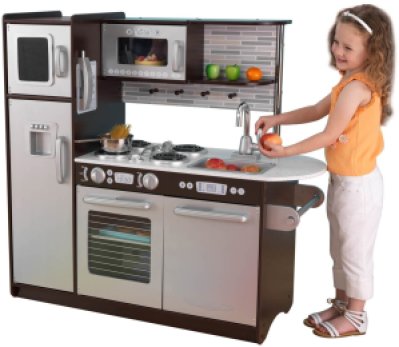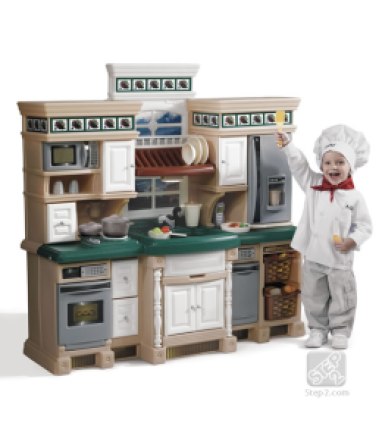If your toddler is anything like Sage, then I can guess your child loves to open and close cabinets and mimic everything that mommy does in the kitchen! From pretending to mix bowls with whisks, to moving kitchenware in and out of cabinets, toddlers enjoy the hustle and bustle of pretend cooking.
Embrace this busy bee stage and encourage a healthy attitude towards food and cooking by letting your child play safely in the kitchen. Toddlers love experiencing new textures and objects. Kitchen utensils, cups and other containers are fun new “toys” toddlers will enjoy.
However, if having your toddler underfoot in the kitchen is too much, there are several great ways to satisfy your child’s inner chef. Play kitchens and the Montessori Learning Tower are two fun options with tremendous developmental benefits for your child.
I’ll tell you more about these fun ways to get your toddler into his or her imaginary chef hat, but first, here’s a rundown of the benefits of pretend play in the kitchen.
Developmental Benefits of Play Kitchens for Toddlers
Pretend play is one of the most essential activities for your toddler’s creativity. Here are some of the many developmental benefits:
- The physical movements used in play kitchens and helping in the actual kitchen develop fine motor skills and coordination.
- The kitchen as a play space also fosters new vocabulary words and concepts for a child’s language skills. Shapes, colors, foods and actions offer new words and a deeper understanding of prepositions, future tenses and adjectives.
- Playing pretend also aids in social skill development. According to Psychology Today, children learn “theory of mind,” or that others can have different thoughts and perspectives from than them, through imaginative play.
- Play kitchens encourage sharing, teamwork and responsibility. Learning to share and work together are two key components of playing together. Play kitchens also promote cleaning up and helping. A good precursor for chores.
- Most importantly, playing with toy kitchens builds self-esteem and creativity.
Types of Play Kitchens and Prices
There are many types of play kitchens for toddlers. Most of them are recommended for children ages three and up, but if your child is already opening and closing cabinets, stacking, standing and showing a desire to play in the kitchen, there’s no reason why this toy won’t be a fun addition to your child’s play space.
KidKraft Play Kitchen
The play kitchens by KidKraft are pretty incredible. They have a realistic look and come in a variety of styles and sizes. You can buy KidKraft from most toy retailers and Amazon.com. My neighbor has the Uptown Espresso Kitchen. It’s a modern-looking kitchen and has the most low cabinets. Sage and his friend Hazel like all the extra cabinets. It’s good for play dates since there’s a lot of space to entertain. Plus, it looks just like their real kitchen!
The downside to this type of kitchen is they take a while to put together. My neighbor said it took about three and a half hours. However, the finished product is great.
Step 2 Play Kitchen
If your toddler is a little more destructive than most, a plastic play kitchen might be the better bet for your household. Step 2 makes a variety of kitchens ranging from $80 to $230. Wooden kitchens can get divots and dents you may not like. However, with plastic kitchens, they are very bright-colored and have stickers for different features instead of paint like the wooden ones. Sometimes the plastic ones also smell, but that probably goes away after a bit. The Step 2 kitchens are taller and may be better suited for older kids.
Ikea Play Kitchen
The most affordable and customizable play kitchen is the DUKTIG Ikea Play Kitchen. You can get one with or without an additional piece on top for $79 or $99 depending on what you want. This kitchen is cute and perfect for small spaces, apartments and condos. However, the sink comes out and it’s pretty plain. If your child likes to take things apart, this may not be the best option for you. However, if you want to customize your kitchen with colors and decor, the Ikea play kitchen is perfect for that. You can get some inspiration on Pinterest.
Montessori Learning Tower
If you’d rather play in the kitchen with real food and kitchenware, the Montessori Learning Tower is an easy and safe way to help your little one get involved. Sage loves his because he can climb up to the counter on his own and help make pizza or any other tasty meal (see photo above). Plus, he can easily do some taste tests for a little snack before dinner.
Toys in the Kitchen
If you’re on a budget, don’t worry! Your child will love to play with kitchenware and cabinets you already have at home. I recommend cleaning out a cabinet and putting in safe objects for play in the kitchen. Plastic bowls, cups and other safe kitchen utensils are great toys for toddlers and babies in the kitchen. Choose objects of different sizes and shapes to add variety. Measuring cups, steamers, and even salad spinners are fun options.
What are some ways you get your toddler involved in cooking and pretend play?




